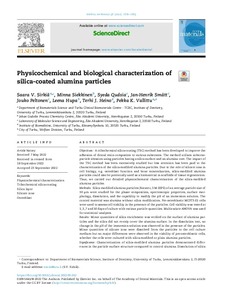Physicochemical and biological characterization of silica-coated alumina particles
Sirkiä Saara V; Siekkinen Minna; Qudsia Syeda; Smått Jan-Henrik; Peltonen Jouko; Hupa Leena; Heino Terhi J; Vallittu Pekka K
https://urn.fi/URN:NBN:fi-fe2022121371236
Tiivistelmä
Objectives
A tribochemical silica-coating (TSC) method has been developed to improve the adhesion of dental resin composites to various substrates. The method utilizes airborne-particle abrasion using particles having a silica surface and an alumina core. The impact of the TSC method has been extensively studied but less attention has been paid to the characterization of the silica-modified alumina particles. Due to the role of silicate ions in cell biology, e.g. osteoblast function and bone mineralization, silica-modified alumina particles could also be potentially used as a biomaterial in scaffolds of tissue regeneration. Thus, we carried out detailed physicochemical characterization of the silica-modified alumina particles.
Methods
Silica-modified alumina particles (Rocatec, 3 M-ESPE) of an average particle size of 30 µm were studied for the phase composition, spectroscopic properties, surface morphology, dissolution, and the capability to modify the pH of an immersion solution. The control material was alumina without silica modification. Pre-osteoblastic MC3T3-E1 cells were used to assess cell viability in the presence of the particles. Cell viability was tested at 1, 3, 7 and 10 days of culture with various particle quantities. Multivariate ANOVA was used for statistical analyses.
Results
Minor quantities of silica enrichment was verified on the surface of alumina particles and the silica did not evenly cover the alumina surface. In the dissolution test, no change in the pH of the immersion solution was observed in the presence of the particles. Minor quantities of silicate ions were dissolved from the particles to the cell culture medium but no major differences were observed in the viability of pre-osteoblastic cells, whether the cells were cultured with silica-modified or plain alumina particles.
Significance
Characterization of silica-modified alumina particles demonstrated differences in the particle surface structure compared to control alumina. Dissolution of silica layer in Tris buffer or SBF solution varied from that of cell culture medium: minor quantities of dissolved Si were observed in cell culture test medium. The cell viability test did not shown significant differences between control alumina and its silica-modified counterpart.
Kokoelmat
- Rinnakkaistallenteet [27094]
